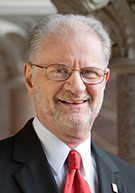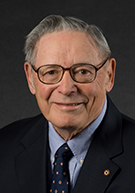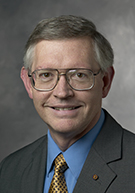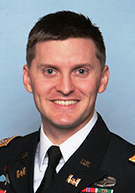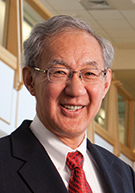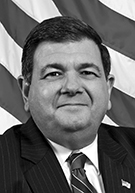It's easy to start your application.
McKelvey Engineering Awards
2013
|
|
As president of Gallaudet University in Washington, D.C., T. Alan Hurwitz, EdD, is at the forefront of higher education for the deaf in the United States. Hurwitz's leadership in the education of the deaf, specifically in higher education, and in advocating for the rights of deaf individuals throughout the nation and the world has elevated the deaf community and society.
After earning a bachelor's degree in electrical engineering from Washington University in 1965, he worked for McDonnell Douglas Corp. in St. Louis as an electronics engineer and computer programmer and analyst for five years. During that time, he earned a master's degree in electrical engineering from Saint Louis University. From there, he transitioned to higher education and spent 40 years at the National Technical Institute for the Deaf (NTID) at the Rochester Institute of Technology. Hurwitz began at NTID as an educational specialist and held a variety of management positions, including president and chief executive officer. At the same time, he earned a doctorate in education from the University of Rochester.
Since January 2010, Hurwitz has led a 1,600-student population at Gallaudet University, the world's only liberal arts university where programs are designed to accommodate students who are deaf or hard of hearing. To many students who are deaf or hard of hearing, Hurwitz is a role model.
Throughout his career, Hurwitz has been involved with many professional and deafness-related organizations including American Coalition of Citizens with Disabilities, Association on Higher Education and Disabilities, American Association of Higher Education, American Society for Deaf Children Inc., Telecommunications for the Deaf, Inc., and American Educational Research Association. Hurwitz is chair of the North Eastern Athletic Conference (NEAC) Presidents' Council, the first deaf person to hold this position in NEAC history. He previously served as the NEAC Presidents' Council vice-chair.
|
|
In September 2012, James V. Leonard, senior technical fellow at Boeing Defense Space & Security, celebrated 50 years with the company. Over the course of his career, he opened the door to integrating the Harpoon missile on the F-16 fighter by developing the Harpoon University Launch Adapter Unit. He also designed and patented new technology that has kept the Harpoon relevant and ready for the warfighter.
Leonard is widely respected in the aerospace electronics industry as an expert in aircraft weapons systems integration in military aircraft. He is one of only 62 technical leaders at Boeing out of 59,000 scientists and engineers. His contributions in the field of weapon systems integration have had a significant technological and economic impact in the military weapons industry and have played a vital role in national security.
At Boeing, Leonard was responsible for integrating the U.S. Navy air-to-surface Harpoon and Standoff Land Attack Missile into the U.S. Navy, U.S. Air Force and foreign aircraft. He is co-inventor on 13 U.S. Patents, two Australian Patents and one European Patent.
After earning a bachelor's degree in electrical engineering from the University of Akron in 1961, Leonard earned a master's degree in electrical engineering from Washington University in St. Louis in 1966 and a second master's degree in electrical engineering from the University of Missouri-Rolla in 1976.
A registered Professional Engineer in Missouri and Ohio, Leonard was elected a Fellow of the Academy of Science St. Louis in 1998. He has received numerous awards and honors over the years, many from the Institute of Electrical and Electronics Engineers (IEEE), to which he has devoted much of his time as a volunteer. He received the IEEE Centennial Medal in 1984 and the IEEE/USAB Achievement Award in 1986.
|
|
|
W. E. Moerner, PhD, is chair of the Department of Chemistry at Stanford University, where he also is the Harry S. Mosher Professor in Chemistry and Professor, by courtesy, of Applied Physics. His research focuses on physical chemistry, chemical physics, single-molecule biophysics, super-resolution imaging and nanoparticle trapping.
Moerner earned three bachelor's degrees, all with honors, from Washington University in St. Louis in 1975 in electrical engineering, physics and mathematics before going on to earn a master's and doctorate in physics from Cornell University. At Washington University, he was an Alexander S. Langsdorf Engineering Fellow, received the Dean's Award for Unusually Exceptional Academic Achievement as well as the Ethan A. H. Shepley Award for Outstanding Achievement.
Moerner created a new field of science — single-molecule spectroscopy and imaging — by being the first to perform optical detection and spectroscopy of a single molecule in condensed matter in 1989. This discovery is widely seen as one of the most important developments in biophysical chemistry, physical/analytical chemistry and chemical physics on the nanoscopic scale during the past two decades. The ability to optically observe individual nanometer-sized molecules is now having a broad interdisciplinary impact, from biophysical and cellular studies of proteins, enzymes, DNA and RNA, to physical/analytical chemistry of rare analytes, to spectroscopy of defects in solids, to materials science of amorphous materials and to single-photon sources of quantum mechanical light.
He has won many awards for his work, including the Peter Debye Award in Physical Chemistry, the Pittsburgh Spectroscopy Award, the Irving Langmuir Prize in Chemical Physics, the Wolf Prize in Chemistry, and is a member of the National Academy of Sciences. He holds 10 U.S. Patents and has others pending. He has published more than 300 papers in scholarly journals.
|
|
|
U.S. Army Capt. Joel Groves has boldly represented his country in three tours of Afghanistan and Iraq since earning a bachelor's degree in mechanical engineering in 2006 on a four-year, Army ROTC scholarship.
As a lieutenant, Groves attended U.S. Army Ranger School, won the 2008 Best Sapper Competition and deployed to Iraq to lead a Route Clearance Platoon. His team proved to be the best in Iraq, finding more improvised explosive devices (IEDs) than any other unit in 2009. As a result, Groves was selected among candidates nationwide to receive the U.S. Army Forces Command 2009 Outstanding Engineer Platoon Leader Award.
After returning from Iraq, Groves joined the 75th Ranger Regiment in Special Operations Command, where he served as director of facilities & construction for an Airborne Ranger Battalion. During his time with the 75th Rangers, he was recognized as the 2010 Officer of the Year for his leadership and performance. The following year, Groves deployed to Afghanistan and was second in command of a Joint Special Operations Task Force comprised of Navy SEALs and Army Rangers.
He has continued to serve Washington University as a mentor to its ROTC cadets in the Gateway Battalion. He provides career advice, mentorship and assignment recommendations to each of the newly commissioned graduates entering the U.S. Army Corps of Engineers.
Currently stationed at Ft. Leonard Wood, Groves recently earned a master's in engineering management from Missouri University of Science & Technology while completing advanced engineer education at the U.S. Army Engineer School. He and his wife, Megan, a 2007 Washington University alumna, will move to Ft. Riley, Kansas, this summer, where Groves will join the 1st Engineer Battalion, the nation's oldest and most decorated engineer unit.
|
|
|
Frank Yin, MD, PhD, is outgoing chair of the Department of Biomedical Engineering at Washington University in St. Louis. Although he is stepping down as chair in June, he will remain the Stephen F. & Camilla T. Brauer Distinguished Professor of Biomedical Engineering.
Yin came to Washington University in St. Louis from the Johns Hopkins University School of Medicine in 1997 to lead the budding biomedical engineering department. During his 15-plus-year tenure, he handpicked 18 of the now 20 world-class faculty members who make up the department, which has become one of the fastest-growing and most successful departments at the university.
A native of China, Yin earned bachelor's and master's degrees from Massachusetts Institute of Technology in 1965 and 1967, respectively. He then earned medical and doctoral degrees from the University of California-San Diego in 1970 and 1973, respectively.
From 1978-1997, Yin had appointments in medicine (cardiology), physiology and biomedical engineering at Johns Hopkins University. His research interests are in soft tissue biomechanics, cell mechanics and hemodynamics. His current research involves determining how cells respond morphologically, functionally and genetically to various mechanical stimuli. In addition, he uses nanoindentation with atomic force microscopy to determine the dynamic mechanical properties of cell and subcellular constituents. This research has applications to tissue healing and remodeling and cancer.
Yin is a founding fellow of the American Institute of Medical and Biological Engineering and a fellow of the American Society of Mechanical Engineers (ASME). He was president of the Biomedical Engineering Society, editor-in-chief of the ASME Journal of Biomechanical Engineering and a member of the national advisory council of the National Institute of Biological Imaging and Bioengineering. He also is a member of numerous academic and industrial advisory boards.
|
|
|
Zachary Lemnios earned a master's degree in electrical engineering from Washington University in St. Louis in 1979 and is an internationally recognized leader in advanced technologies for national security.
He recently took the helm as vice president for research strategy at IBM, where he is responsible for outlining the research strategy across IBM's 12 global labs, transitioning innovative research concepts to products and leading the IBM Global Technology Outlook.
Previously, Lemnios served three terms in the U.S. Department of Defense. He was confirmed as the Honorable Assistant Secretary of Defense (Research & Engineering) by the U.S. Senate. In this position, Lemnios was the chief technology officer for the Department of Defense and shaped the department's technical strategy to support the President's national security objectives and the Secretary's priorities. He launched a variety of department and international initiatives including large data analytics, decision support, engineering education and electronic warfare concepts as future capabilities for the nation.
Lemnios served in the Defense Advanced Research Projects Agency, leading two offices that launched the deeply scaled microelectronics, semiconductor manufacturing, photonics, MEMS and cognitive system revolutions in industry.
Lemnios was the first chief technology officer of MIT Lincoln Laboratory and assistant division head of the Solid State Division. He held technical positions within Hughes Aircraft Co., Westinghouse Electric Corp. and Ford Microelectronics Inc. and pioneered early GaAs device, integrated circuit and manufacturing concepts.
Lemnios earned a bachelor's degree in electrical engineering from the University of Michigan. He has served on numerous national security, industry and academic committees. He has written more than 40 papers, holds four patents and is a senior member of the IEEE. He received special recognition from the Australian Government Department of Defence and was awarded Office of Secretary of Defense Medal for Exceptional Public Service.

